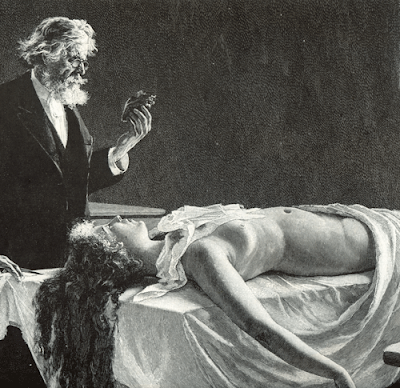 I think I will do a little dissection tonight, I will attempt the dangerous and difficult self autopsy. Which must of necessity be preformed entirely without anesthesia. Below is the painting I showed you yesterday.
I think I will do a little dissection tonight, I will attempt the dangerous and difficult self autopsy. Which must of necessity be preformed entirely without anesthesia. Below is the painting I showed you yesterday.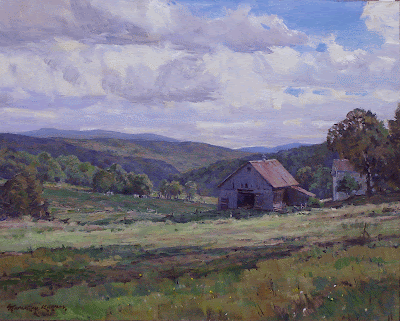 This painting was started last fall on location in northern Vermont. It is a 16x20 which is a common size for me. Often the squareness of a canvas is relative to the distance portrayed in my work. For instance I would tend to paint a forest interior or a street scene on a squarish canvas. I would usually paint a broad vista on an elongated canvas. So it is a little unusual for me to be painting a scene this large on a 16x20 but I brought a whole lot of them on the trip, in part to force myself to work that size. I will sometimes do things like that to jar me out of my usual ways of doing things. I would have known instinctively how to put this on to a 24 x 36 .
This painting was started last fall on location in northern Vermont. It is a 16x20 which is a common size for me. Often the squareness of a canvas is relative to the distance portrayed in my work. For instance I would tend to paint a forest interior or a street scene on a squarish canvas. I would usually paint a broad vista on an elongated canvas. So it is a little unusual for me to be painting a scene this large on a 16x20 but I brought a whole lot of them on the trip, in part to force myself to work that size. I will sometimes do things like that to jar me out of my usual ways of doing things. I would have known instinctively how to put this on to a 24 x 36 .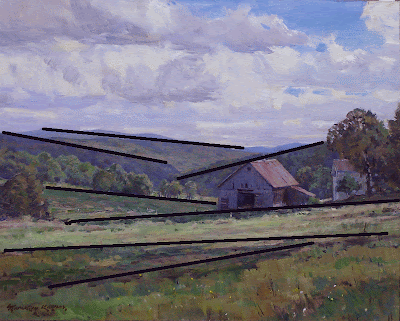 There are a series of receding diagonal lines in this painting. Their slopes pretty much alternate, each one balancing the previous with a thrust in the opposite direction. These wedges are a common landscape tool and lots of artists use this device. I invented cloud shadow in order to darken my foreground . That is also a real traditional device. Here's an example of another painter using it.
There are a series of receding diagonal lines in this painting. Their slopes pretty much alternate, each one balancing the previous with a thrust in the opposite direction. These wedges are a common landscape tool and lots of artists use this device. I invented cloud shadow in order to darken my foreground . That is also a real traditional device. Here's an example of another painter using it. This is of course a Jan Van Goyen courtesy of artrenewal.org. It is really not so much about the shadowed foreground itself as it is about setting up for the swath of light across the center. If it were not bounded by darks it would not seem to be a light. Out in that band of light I have my subject matter, the barn etc..
This is of course a Jan Van Goyen courtesy of artrenewal.org. It is really not so much about the shadowed foreground itself as it is about setting up for the swath of light across the center. If it were not bounded by darks it would not seem to be a light. Out in that band of light I have my subject matter, the barn etc..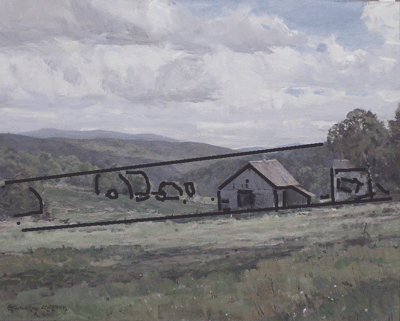 In a diagonal band including that barn is everything important in the painting. This is the stage and the barn and the house and the little cows are my actors. The shadowed foreground and the mountains in the distance are just gathered about this band to set it off. Notice that I have placed the band not in the middle of the landscape part of the painting, but starting more than halfway up. If I had placed that band across the center of the landscape it would have looked static. The level of detail and resolution is greatest in this subject area the edges are a little harder and of course I have some reds in that barn roof which beckon the eye to that area. I have kept them as understated as I can, no louder than what it takes to do the job.
In a diagonal band including that barn is everything important in the painting. This is the stage and the barn and the house and the little cows are my actors. The shadowed foreground and the mountains in the distance are just gathered about this band to set it off. Notice that I have placed the band not in the middle of the landscape part of the painting, but starting more than halfway up. If I had placed that band across the center of the landscape it would have looked static. The level of detail and resolution is greatest in this subject area the edges are a little harder and of course I have some reds in that barn roof which beckon the eye to that area. I have kept them as understated as I can, no louder than what it takes to do the job.Arranged in my decorative subject matter band, like a string of pearls are a number of objects having great variety of shape and size. The house is turned for instance at a different angle than the barn and the trees are rounded shapes offsetting the geometric squarness of the architecture, sprinkled across the whole is an arrangement of little fence posts, and cattle and illuminated tufts of grass that are rhythmic accents. As I said before, almost everything in this picture is going on within that band.
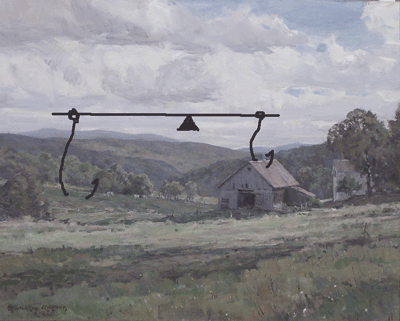 Here is the balance scheme of the painting. It is a classic too. The area of interest is balanced by the broad but more empty shape to its left. The more interesting shape, the barn sits closer to the fulcrum while the larger field shape sits further from the center. This gives the painting a balance of asymmetrical parts. Again very classical.
Here is the balance scheme of the painting. It is a classic too. The area of interest is balanced by the broad but more empty shape to its left. The more interesting shape, the barn sits closer to the fulcrum while the larger field shape sits further from the center. This gives the painting a balance of asymmetrical parts. Again very classical.Below is a close up of the right foreground showing the visible brush stroke. I like to ride the line between brushstroke and the look of "vision" Its a painting , its a scene, its a painting, its a scene. At a short distance away it melds into the image but up close there is brushwork. I like the restraint of that . Rather than being really about the brushwork or totally a representation, the painting dances along that line in between. There is broad brush work but the thing is still resolved to a pretty high degree. It is not loose in a conventional sense but the hand of the maker is visible. Brushwork is an element of style. I sometimes joke that I am the worlds tightest impressionist!
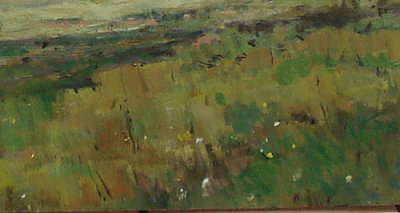 Here is a shot of the foreground in detail so you can see the brushwork in that. Below is a detail of the sky.
Here is a shot of the foreground in detail so you can see the brushwork in that. Below is a detail of the sky.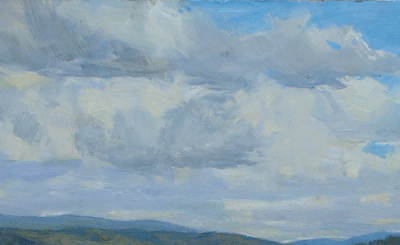 The sky at the top of the painting and the foreground of the painting are far more loosely painted than my middle band of detail. They are really accessories and I don't want them to be too assertive and compete with my subject.
The sky at the top of the painting and the foreground of the painting are far more loosely painted than my middle band of detail. They are really accessories and I don't want them to be too assertive and compete with my subject.I am up to the same balancing act with my color also. I use fairly saturated color but I neutralize it with compliments or surround it with other colors that keep it from being too assertive. I am after a middle course with my color too. Its not really, really bright but not really grave either. Again I like the beauty of the restrained color. When I go in the museum almost all of the paintings made today seem vulgar in their coloration.
Vulgarity is the enemy, we have plenty of vulgar out there already, particularly in the art world. Lets rebel! We could have some class for a change. Now there's a cutting edge idea.




6 comments:
That sky/horizon placement is what stymies me a lot. I was surprised to see that Seago often goes for placing it and his center of interest in the bottom fourth of the canvas, I suppose so he can have all those clouds to work with. Here you went for a mid point. Lately I have been using higher horizons to get my centers of interest into the right places but that cuts out a lot of that nice patches of blue. WillEK
Stape,
When talking about your foreground you mentioned that at a short distance away your brushwork melts in the image which makes the scene but up close you see only brush work, which makes the painting.
Do you squint alot at your painting in order for you to achieve this secne through your brush work?
JAMES
Very insightful. Do you wait for the painting to dry completely before working on it, or are you painting over/scraping back while it is still wet?
Willek:
There isn't a right or wrong, although putting that horizon right in the middle is almost always a mistake. Seago painted low horizons because he lived in the low country. Fens and marshes. If you were painting in the mountains you might paint with a high horizon.
.......Stape
James.
I suppose I do squint, but I don,t necessarily observe what I paint, I choose how the thing is going to look based on nature not by transcribing it. I am a decision maker.
....Stape
Jeremy;
I usually prefer to work on it again when it is dry. Since I use an alkyd medium that usually doesn't take long. I will work on it wet too. Its not really a big deal to me. The beauty of having it dry though, is if I screw up, I can wipe pack to what I had before.
....Stape
Post a Comment